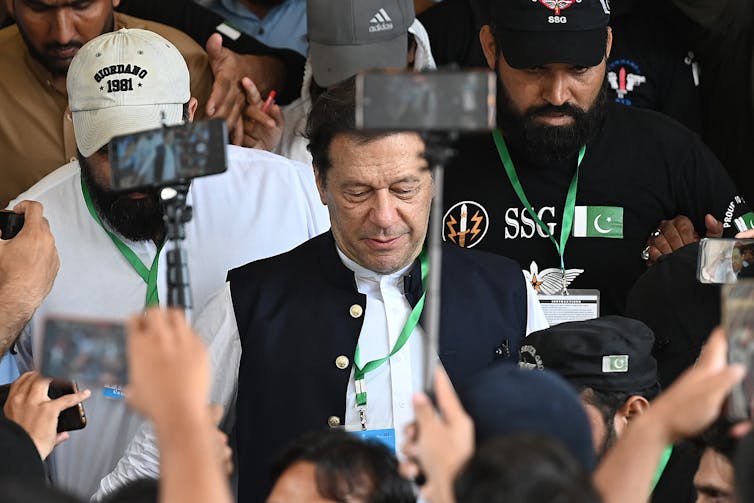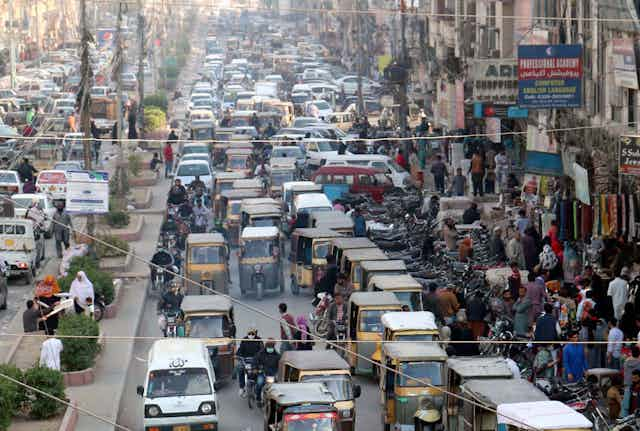Pakistan is showing clear signs of economic and political crisis. Inflation was recently almost 38%, and the country faces a debt crunch as it tries to manage its trade deficit with the rest of the world. Talks with the IMF over emergency loans have dragged on for months.
On the political side, elections are being delayed in the aftermath of the controversial arrest of former prime minister Imran Khan, which led to widespread protests.
Some of these events coincided with a conference I attended recently in Pakistan, where there was actually much positive discussion of the country’s economic potential – particularly with regards to improved relations with central Asia.
Several countries in central Asia (Tajikistan, Uzbekistan, Kazakhstan, Turkmenistan, Kyrgyzstan) can provide what Pakistan needs – wheat, gas and oil – to help it cope with rampant food and energy price rises.
In return, Pakistan has what central Asia needs – the ability to transport central Asian goods south to large ports in Gwadar and Karachi, potentially transforming the region into one which is “land-linked” as opposed to land-locked.

But the state of Pakistan’s relationship with central Asia is complicated. The vast expanse of the Himalayas which separates them is not just a massive physical obstacle – it is also a metaphor for the many centuries of economic, political and cultural estrangement between the two regions. And central Asia can seem disinclined to look southwards in its international ambitions.
In foreign policy, the gaze of central Asia is now resolutely north towards Russia. Earlier this year, all five presidents of central Asia visited Moscow for the annual Victory Day holiday where they applauded Putin’s speech.
Meanwhile, in economics, central Asia looks resolutely east towards China. In 2022, Kazakhstan exported US$13.2 billion (£10.3 billion) of goods and services to China. Two years earlier, by comparison, it exported less than US$20 million to Pakistan.
Yet there are signs of improvement. In 2021 Pakistan and Uzbekistan, together with Afghanistan, signed off on a US$5 billion project to build a 573km railway line connecting their three capital cities, which still looks promising. The Turkmenistan-Afghanistan-Pakistan-India gas pipeline has been under construction since 2015.
Meanwhile, China is pouring more than US$60 billion into a network of road, rail, energy, energy pipelines and fibre optics to link it with Pakistan. And while the “China Pakistan Economic Corridor” is expected to have positive implications for trade, investment and technology transfer between the two countries, it is also likely to generate major benefits for the wider region, improving transport links between southern and central Asia.
A second Singapore?
With political and bureaucratic will, this could inspire a far better connection between Pakistan and central Asia, where Pakistan could seek to emulate the role that Singapore took on in the 1960s and 1970s. Acting as a link between east and west, Singapore helped to drive globalisation as well as its own soaring economic growth.
At the time, Singapore was perfectly placed to connect cheap labour in the east with investment and technology from the west. But it was not a wholly smooth transition.
For while Pakistan today faces the threat of Islamic extremism, in the 1960s Singapore faced a local communist insurgency, and bombings were a regular part of a four-year long Indonesian state-backed campaign. Yet Singapore does show that such threats can be overcome.
The key will be gaining sufficient political stability to encourage investors that Pakistan is a good bet, something achieved by the “benevolent autocracy” of Lee Kuan Yew, under which Singaporeans arguably traded off certain social and political freedoms for stability and prosperity.

Today, Pakistan sits aside many of the principal crossroads of the global economy. It has long been a close partner of China, and has has unparalleled diplomatic and cultural reach into Afghanistan and the Middle East. It is already deeply embedded in the west through a well-established diaspora.
But we shouldn’t forget the elephant in the room when it comes to any discussion about regional connectivity – and that is India. Any historic or cultural connections Pakistan has with central Asia are dwarfed by those it retains with its next door neighbour.
The national languages of India (English and Hindi) are completely comprehensible to Pakistan (English and Urdu). The two countries share traditions in English law and parliamentary political systems, and both speak the cultural languages of cricket and Bollywood films.
Reconnecting India and Pakistan does not require new infrastructure – the roads and routes are already there; they just aren’t being used to their full potential. In fact, the World Bank estimates that untapped trade between India and Pakistan in 2015 was US$35 billion (compared to just over US$2 billion of existing annual trade).
Peace and openness with India would not just complete the reconnection of South Asia, but also offer Pakistan the chance to become a genuine regional hub – a Singapore for the 21st century. And if freedom to trade could take any of the nuclear heat out of Pakistan-India relations – what former US president Bill Clinton called “the most dangerous place on earth” – then regional endeavours would have globally transformational benefits.

